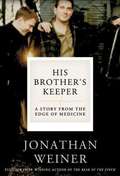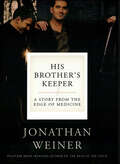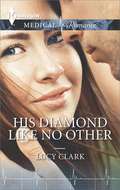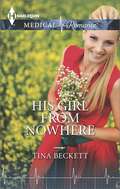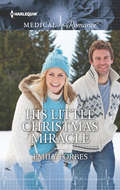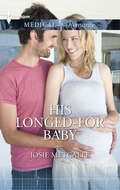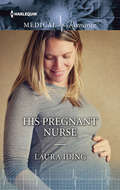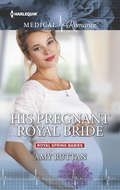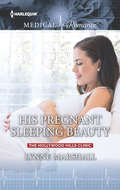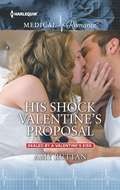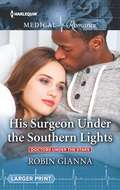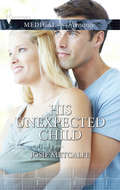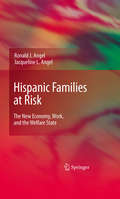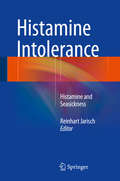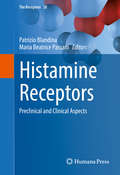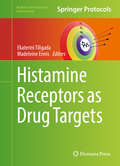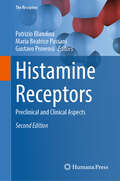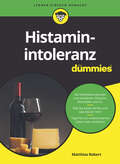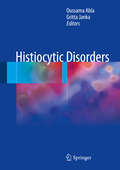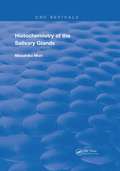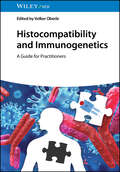- Table View
- List View
His Brother's Keeper: A Story from the Edge of Medicine
by Jonathan WeinerFrom the Pulitzer Prize-winning author of "The Beak of the Finch" comes a book about the new biology and how it touches a defiant family-in-crisis fighting an incurable disease.
His Brother's Keeper: A Story from the Edge of Medicine
by Jonathan WeinerStephen Heywood was twenty-nine years old when he learned that he was dying of ALS -- Lou Gehrig's disease. Almost overnight his older brother, Jamie, turned himself into a genetic engineer in a quixotic race to cure the incurable. His Brother's Keeper is a powerful account of their story, as they travel together to the edge of medicine.The book brings home for all of us the hopes and fears of the new biology. In this dramatic and suspenseful narrative, Jonathan Weiner gives us a remarkable portrait of science and medicine today. We learn about gene therapy, stem cells, brain vaccines, and other novel treatments for such nerve-death diseases as ALS, Alzheimer's, and Parkinson's -- diseases that afflict millions, and touch the lives of many more."The Heywoods' story taught me many things about the nature of healing in the new millennium," Weiner writes. "They also taught me about what has not changed since the time of the ancients and may never change as long as there are human beings -- about what Lucretius calls 'the ever-living wound of love.'"This P.S. edition features an extra 16 pages of insights into the book, including author interviews, recommended reading, and more.
His Cinderella Houseguest
by Charlotte HawkesWill a dazzling kiss with his Cinderella be enough to convince her to stay forever? Find out what happens in this fairy-tale medical romance by Charlotte Hawkes.When midnight strikes…Will his Cinderella stay in his arms? Helicopter pilot Piper Green is supposed to be Dr. Lincoln Oakes&’s new air ambulance colleague—not his houseguest! Yet discovering she&’s practically homeless, he offers her his spare room. In such close quarters, sparks soon start to fly, but they agree to keep things strictly professional. Until a dazzling kiss makes their chemistry impossible to ignore… But Piper has a secret and when Linc learns the truth, could their chance at happy-ever-after disappear?From Harlequin Medical: Life and love in the world of modern medicine.
His Diamond Like No Other
by Lucy ClarkDazzled by a Diamond...Seeing Jane Diamond on his ward is enough to stir up deep-buried hurts from handsome Dr. Sean Brooke's past. She might be a highly successful pediatrician, but after Sean's disastrous marriage to her sister, Jane is the last person he wants to work with! And he certainly doesn't want to meet his son.... But as he spends time with this shy beauty, Sean soon realizes that there's more to Jane than meets the eye. Could this Diamond really be his shining light?
His Girl From Nowhere
by Tina Beckett"I can't tell you..."Equine therapist Trisha Bolton has a secret. One she's not allowed to tell anyone. Finally given the chance to start over, she just needs the backing of local ultragorgeous neurosurgeon Mike Dunning!No stranger to betrayal, Mike has every reason to be wary of Trisha. Yet each touch sparks long-extinguished flames in Mike, and soon their sessions in the barn become more steamy than either of them bargained for! Mike's had enough of secrets in his life. But can he convince Trisha that she can trust him with hers?
His Honorable Surgeon
by Kate HardyA high-society surgeon…and the consultant next doorThe Honorable Victoria Radley is almost too honorable a doctor for her own good! Highly ambitious and devoted to her patients, there's no time for love in her life, much to the paparazzo's dismay!New consultant neurologist Jake Lewis quickly recognizes Vicky's qualities. They might be opposites, their backgrounds couldn't be more different, yet the two become inseparable—once Jake has persuadedThen a potentially life-threatening condition leaves their relationship hanging in the balance. Except, Vicky realizes Jake is the only man who can help her.
His Little Christmas Miracle
by Emily ForbesThe greatest gift of all... Seven years ago pretty nurse Jess Johnson gave away her heart...to gorgeous Australian Lucas White. It was only after she was torn from Lucas's arms that Jess discovered she was pregnant-and she hasn't seen him since! Returning to beautiful Moose River, Jess is stunned to learn that Lucas is in town, too! Seeing one another again ignites a flame in their hearts that is impossible to ignore. But Jess has one more Christmas miracle in store for Lucas...their adorable little daughter, Lily!
His Longed-For Baby
by Josie MetcalfeDr. Lascelles' secret dream come true...Her lifelong wish for a family is so close to coming true. But Dr. Maggie ffrench's dream is shattered when on the eve of her marriage the wedding is canceled. In the emotional aftermath Maggie finds herself making passionate love to her boss, Jake Lascelles--a man she once loved and had thought loved her, too, until he withdrew from her. Now Maggie is pregnant with his child. She doesn't know why he won't believe her, but she does know she must convince him that it's true...
His Perfect Bride?
by Louisa HeatonLove where he least expects it... GP Oliver James knows exactly what his "perfect bride" should be like-and vibrant, unconventional new locum Lula Chance is the total opposite! Yet there's something about beautiful Lula and the heartbreak in her eyes that intrigues him... Lula's determined not to be distracted by brooding bachelor Oliver...no matter how gorgeous he is. She's arrived in Atlee Wold hoping to find her mother. But it's only a matter of time before she gives in to the inevitable... Perhaps Lula might just be Oliver's perfect bride after all?
His Pregnant Nurse
by Laura IdingComing soon! His Pregnant Nurse by Laura Iding will be available Sep 12, 2016.
His Pregnant Royal Bride
by Amy RuttanPregnant with the prince's baby Nurse Shay Labadie's one exquisite night of passion with Dr. Dante Affini was meant to be a beautiful memory. But now Shay's expecting...and Dante is expecting her to take his hand in marriage! Dante's proposal is shocking enough, but then he drops an even bigger bombshell-he's not just a doctor, he's a prince! Now to win his child and the woman he loves, Dante will have to prove he can master his most important role yet-as the husband Shay deserves...
His Pregnant Sleeping Beauty: His Pregnant Sleeping Beauty Twin Surprise For The Single Doc The Army Doc's Secret Wife (The Hollywood Hills Clinic #6)
by Lynne MarshallRescuing the runaway When paramedic Joseph Matthews rescues a vulnerable pregnant woman left in a coma, he vows to be there for his Sleeping Beauty. Even though after his ex-wife's betrayal everything about innocent Carey Spencer evokes bittersweet memories...mixed with unexpected desire. As Joseph helps gorgeous Carey recover and build a safe new future for her unborn baby, can he gather his courage to give them the happy-ever-after they deserve?
His Shock Valentine's Proposal
by Amy RuttanFrom rivals...to romance? New doctor in town Esme Petersen is direct competition for GP Carson Ralston and he isn't pleased. Especially as her beauty and disarming manner threaten the barriers he's carefully built around his heart... Guarded Esme tries to keep Carson at a distance. But as the battle for power between them heats up, rivalry soon turns to insatiable passion. And a shock Valentine's proposal changes everything!
His Surgeon Under the Southern Lights: His Surgeon Under The Southern Lights (doctors Under The Stars) / Reunited In The Snow (doctors Under The Stars) (Doctors Under the Stars #1)
by Robin GiannaThe lone-wolf doc……meets his match!In this Doctors Under the Stars story, only when exploring the Antarctic’s freezing waters can marine biologist Dr. Zeke Edwards forget the heartache of losing his family. Until an unexpected, passionate kiss with new colleague Dr. Jordan Flynn starts to break through the barriers around his heart. Having both sworn off relationships they agree to a temporary fling. Then danger strikes…and they’re forced to realize their feelings are anything but temporary!Doctors Under the Stars duetBook 1 — His Surgeon Under the Southern LightsBook 2 — Reunited in the Snow“What an emotionally-charged and well-developed read Ms. Gianna has delivered in this book…it was from the moment the hero and heroine come face-to-face for the first time that made this story a real page turner….”— Harlequin Junkie on The Family They’ve Longed For“This is an absolutely brilliant…encompassing story that captivated my undivided attention immediately with the opening line and kept me entertained from start to finish. Everything about it — the incredible main characters, the compelling dialogue and the fast-paced plot — made this story…a splendid read….”— Harlequin Junkie on Tempted by the Brooding Surgeon
His Unexpected Child
by Josie MetcalfeMaking miracles... Helping couples fulfill their dream of becoming parents brings such delight to Dr. Leah Dawson, especially as she cannot carry a baby to full term herself. After a series of miscarriages led to the breakdown of her marriage, Leah has given everything to her work--and she's infuriated when a promotion is taken from her by the gorgeous Dr. David ffrench! Yet her new boss's skills as a doctor, and the special care he takes with his patients--and with Leah--is enough to steal her heart. Their relationship deepens, and then Leah discovers she's pregnant...
Hispanic Families at Risk
by Ronald J. Angel Jacqueline L. AngelIn the United States, work is the key to economic success, as well as the major source of health care coverage and retirement security. While Europeans look to the State for these benefits, Americans for the most part do not. This system of employment-based benefits means that those disadvantaged in the labor market are also disadvantaged in terms of health care coverage and retirement security. The authors of this work examine the overrepresentation of Mexican Americans in low wage or service sector jobs, which rarely come with health insurance or retirement coverage. At all ages, Mexican Americans have lower rates of health insurance and retirement coverage than do other minority groups, such as African Americans or other Hispanic groups. Although employment in jobs that do not provide benefits is one major source of this disparity, other factors--including immigration history, citizenship status, and language proficiency--further block opportunities for upward mobility within the Mexican American population. In their analysis, the authors work to deemphasize the popular, cultural explanation for the economic disparities and focus on more practical, policy-based solutions. In each chapter, the authors identify and critique the factors that affect the economic security and health care access of individuals throughout the life course, suggesting policies for reform. This work will be of interest to anyone working in the fields of cultural studies, public health and the sociology of work. With the focus on real world causes for the problems as well as potential solutions, policy-makers will also find this informative book an essential resource.
Histamine Intolerance
by Reinhart JarischHistamine is an important mediator of allergic diseases, but knowledge of histamine as a cause of numerous non-allergic symptoms and signs is limited. This book offers wide-ranging coverage of histamine intolerance. There is extensive background discussion of the origin of histamine, its content in food and alcoholic beverages and intolerance to red wine. Diagnosis of histamine intolerance is explained and the various symptoms of histamine intolerance are clearly described. Subsequent chapters cover the relation of histamine to a wide variety of conditions, including drug intolerance, atopic dermatitis, seasickness and osteoporosis. This book will prove of value in clinical practice by facilitating differential diagnosis, which is by no means straightforward given the multiplicity of symptoms of histamine intolerance and by assisting in the selection of therapeutic measures.
Histamine Receptors
by Patrizio Blandina Maria Beatrice PassaniA comprehensive and detailed overview of the current state of preclinical research on histamine and histamine receptors. Part of the book focuses on novel approaches to the study of histamine receptors such as polymorphism, genetic linkage, and computational analysis, and on the use of new histaminergic ligands in diseases such as asthma and dermatitis. Several chapters will be devoted to the role of histamine in the control of homeostatic and behavioral responses such as the sleep-wake cycle, regulation of the blood brain barrier, food intake, alertness, itch, and memory formation and consolidation.
Histamine Receptors as Drug Targets
by Ekaterini Tiligada Madeleine EnnisThis book illustrates the current state-of-the-art in histamine research, with a focus on the appropriate methodologies to investigate the pharmacological properties and the therapeutic exploitation of HRs and their ligands. In addition, the range of techniques described provides an introduction to complementary cross-methodological disciplines beyond these fields. This multi-disciplinary approach is required to define the 'decision gates' that determine the development of more effective and safer therapeutic options for many forms of highly prevalent and debilitating diseases, such as asthma, dementias, dermatitis, and arthritis. Written for the Methods in Pharmacology and Toxicology series, chapters concentrate on practical, hands-on protocols from experts in the techniques. Authoritative and thorough, Histamine Receptors as Drug Targets seeks to aid pharmacologists, biochemists, drug discovery researchers, molecular biologists, chemists, toxicologists, lab scientists, medical doctors, principle investigators, research scientists, lab directors and technicians, as well as graduate students around the world in pursuing the study of this vital scientific area.
Histamine Receptors: Preclinical and Clinical Aspects (The Receptors #28)
by Patrizio Blandina Maria Beatrice PassaniA comprehensive and detailed overview of the current state of preclinical research on histamine and histamine receptors. Part of the book focuses on novel approaches to the study of histamine receptors such as polymorphism, genetic linkage, and computational analysis, and on the use of new histaminergic ligands in diseases such as asthma and dermatitis. Several chapters will be devoted to the role of histamine in the control of homeostatic and behavioral responses such as the sleep-wake cycle, regulation of the blood brain barrier, food intake, alertness, itch, and memory formation and consolidation.
Histamine Receptors: Preclinical and Clinical Aspects (The Receptors)
by Patrizio Blandina Maria Beatrice Passani Gustavo ProvensiThis new edition provides a comprehensive and authoritative overview of the current state of both preclinical and clinical research on histamine and its receptors. It explores novel investigative approaches, including receptor polymorphisms, genetic linkage analysis, and computational modeling. Additionally, it examines the application of new histaminergic ligands in the treatment of various diseases, such as asthma and atopic dermatitis. Several chapters are dedicated to the role of histamine in regulating homeostatic and behavioral functions, including the sleep–wake cycle, appetite control, alertness, pruritus (itch), and the processes of memory formation and consolidation. This edition also introduces newly added chapters focusing on the roles of histamine and its receptors in the kidneys and eyes, both in physiological and pathological contexts, as well as their involvement in motivational processes.
Histaminintoleranz für Dummies (Für Dummies)
by Matthias RobertLeiden auch Sie unter Histaminintoleranz oder vermuten Sie es zumindest? Sind Sie durch die Symptome dazu gezwungen sich einzuschränken? Keine Sorge, in diesem Buch erfahren Sie alles, was Sie über Histaminintoleranz wissen sollten. Der Autor hilft Ihnen die Krankheit zu verstehen und erklärt, was die Histaminausschüttung alles beeinflussen kann. Sie erfahren welche Symptome möglich sind, wie Sie zu einer sicheren Diagnose gelangen und wie es danach weiter geht. Auch andere Mastzellerkrankungen wie Allergien, Kreuzreaktionen und das Mastzellaktivierungssyndrom MCAS kommen nicht zu kurz. So finden Sie endlich zurück zur gewohnten Lebensqualität.
Histiocytic Disorders
by Oussama Abla Gritta JankaThis volume provides a comprehensive and world-class review of the field of histiocytic neoplasms and hemophagocytic lymphohistiocytosis (HLH). It reviews all the advances in the field of histiocytoses during the last ten years, particularly with regards to the genomic findings in LCH and other histiocytic neoplasms and the new suggested classification of the histiocytic disorders. Additionally, it features a state-of-the art update on the most recent treatment strategies for LCH, including the results of the last LCH-III international trial, salvage therapies such as reduced-intensity conditioning (RIC) stem cell transplant (SCT), and targeted therapies with BRAF and MEK inhibitors, as well as the challenging cases of CNS-neurodegenerative LCH and its therapeutic perspectives. For primary and secondary HLH the book updates the most recent genetic and pathophysiological findings, including macrophage-activation syndrome (MAS), and includes a special chapter on HLH in adults. Treatment chapters encompass therapy for newly diagnosed HLH and refractory disease as well as stem-cell transplantation and novel therapies. The text also highlights the most recent advances in the treatment of the uncommon histiocytic disorders, such as Erdheim-Chester disease (ECD), Juvenile xanthogranuloma (JXG) and JXG-like conditions, Rosai-Dorfman disease (RDD), and the very rare malignant histiocytoses. Written by international experts in the field, Histiocytic Disorders is a valuable resource for clinicians, researchers, fellows and residents who are interested in or manage histiocytic disorders in children and adults.
Histochemistry of the Salivary Glands (Routledge Revivals)
by Masahiko MoriFirst published in 1991, Histochemistry of the Salivary Glands is a well-structured, in depth exploration of Cytoskeletal proteins and their function. With references and data from numerous sources, this book is essential for students of medicine and practitioners in their respective fields.
Histocompatibility and Immunogenetics: A Guide for Practitioners
by Volker OberleThe EFI-, ASHI-, and APHIA-endorsed professional guide for laboratory diagnostics in transplantation medicine In Histocompatibility and Immunogenetics: A Guide for Practitioners, expert authors from across the globe deliver an authoritative introduction to the concepts, methods, and clinical applications of matching donors with acceptors of transplanted cells and organs. Fundamental concepts and limitations of current immunogenetic as well as histocompatibility diagnostic approaches are explained, and best practices to improving the outcomes of transplantation therapies are discussed. Readers will also find: A holistic view of transplantation diagnostics, including drug and disease associations with histocompatibility markers Options for the medical treatment of organ rejection Practical discussions of specific methods in immunogenetics and histocompatibility, such as crossmatching in transplantation and KIR genotyping A thorough introduction to the regulatory aspects of histocompatibility and immunogenetics Perfect for clinical geneticists and immunologists, Histocompatibility and Immunogenetics will also benefit medical and research professionals working in medical laboratories and hospitals.
